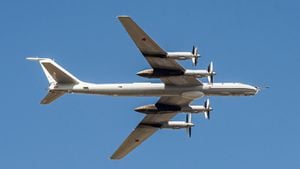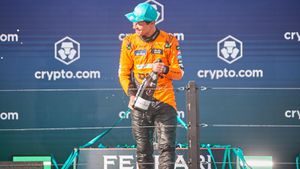In a dramatic turn of events, NASA is currently evaluating whether to bring back its astronauts stuck aboard Boeing's troubled Starliner spacecraft, or to look toSpaceX's Crew Dragon as a viable alternative. The complexities surrounding the Starliner have seemingly devolved into a concerning situation, as Boeing's spacecraft has faced numerous technical issues after a series of delays. This leaves both NASA and Boeing in uncertain waters as they try to ensure the safety and timely return of astronauts Butch Wilmore and Suni Williams.
This predicament began on June 5, when the Starliner was launched on an Atlas V rocket on what was expected to be a routine mission to the International Space Station (ISS). Initially, the astronauts were slated to return to Earth by June 14. However, various anomalies quickly escalated, and as of now, the duo has been in space for nearly two months.
NASA initially downplayed the impact of certain problems, citing addressable issues like helium leaks and thruster failures that were manageable at the time. Boeing's Mark Nappi characterized these incidents as relatively minor, assuring the public that they would be ironed out before the next mission. But as days turned into weeks, the problems continued to weigh heavily on both NASA and Boeing’s leadership.
As of now, concerns primarily revolve around the performance of Starliner’s reaction control system thrusters, which have exhibited inconsistencies essential for steering during critical phases such as departing the ISS and re-entering Earth’s atmosphere. Despite extensive testing conducted at White Sands Test Facility and additional hot-firing tests in space, a complete understanding of the failures remains elusive. Each test has contributed valuable data; however, it appears there might still be fundamental issues that need resolving before a safe return home can be ensured.
Interestingly, the ongoing testing process has been coupled with discussions regarding alternatives, particularly SpaceX's Crew Dragon. Recent reports suggest that NASA officials are contemplating sending the astronauts back to Earth on a SpaceX capsule instead of Starliner due to lingering uncertainties surrounding Boeing's spacecraft. An informed source noted that the possibility of using the Dragon is looking more favorable, stating that the probability that the astronauts will end up coming back on that platform has crossed the 50 percent threshold. This marks a stark contrast from NASA's previous assertions about Starliner being the primary option for astronaut return.
In an effort to remain cautious, NASA allocated funding for a “special study for emergency response” to SpaceX, signaling the agency's serious consideration of launching a rescue mission if necessary. SpaceX has been busy preparing for the potential scenario of sending a Dragon capsule to the ISS to retrieve the stranded astronauts. There is talk of possibly flying both Crew-9 and also looking into accommodating Wilmore and Williams in the upcoming missions, exemplifying the dual focus on maintaining safety while also planning for a conceivable recovery.
Navigating these uncharted waters means that NASA is now entrusting its Commercial Crew Program in a manner that puts Boeing’s credibility on trial. Whether or not the Starliner can complete its mission without incurring additional risk is paramount not only for the astronauts' well-being but also for the future of Boeing’s involvement in NASA contracts. With losses already nearing $1.6 billion, further setbacks could spell the end for the program, leaving NASA reliant on another solution for crew transportation.
Amid this chaos, both Wilmore and Williams remain upbeat. Their experience as seasoned astronauts and Navy test pilots has allowed them a certain level of composure in an otherwise fraught situation. Referring to their unique position aboard the ISS, Williams reflected that “everything’s in place, as far as what we know now,” suggesting that they have confidence in the decision-making processes taking place back on Earth as long as necessary precautions are taken.
As for the Starliner mission, while it continues to be framed internally as a learning exercise, there is an underlying urgency to address the situation more assertively. The existence of protocols relating to orbital debris—such as during a close encounter with Russian satellite debris—serves as a reminder of the risks that come with space missions. Whenever necessary, crews can “shelter” in their respective spacecraft, which could lead to safe extraction in emergency circumstances.
However, the overall goal for NASA and Boeing remains straightforward: ensure the safe return of Wilmore and Williams without undue risk. Thus far, the teams have displayed remarkable patience, but the ticking clock is pushing them towards a resolution. As they approach critical decision points in the coming days, the implications extend beyond immediate rescue options; they seep into perceptions about reliability, cost effectiveness, and the balance of roles between private sector partners in the realm of space exploration.
The conversations surrounding Starliner highlight not only the inherent risks of space travel but also the complexities of privatized space efforts under government contracts. With Boeing continuing to assert confidence in their spacecraft, the stakes remain high, particularly as the trajectory of the mission determines not only how safely the astronauts can return home but also the reputation of Boeing in future NASA dealings. As a vital provider of commercial crew transport, Boeing's ability to follow through on their commitments will be increasingly scrutinized.
Ultimately, the mission reflects a critical testing ground for human spaceflight in a rapidly evolving framework between governmental and commercial partnerships. In light of NASA's shifting position on astronaut return options, it remains a waiting game for the agency, Boeing, SpaceX, and—most importantly—the astronauts stranded among the stars.



